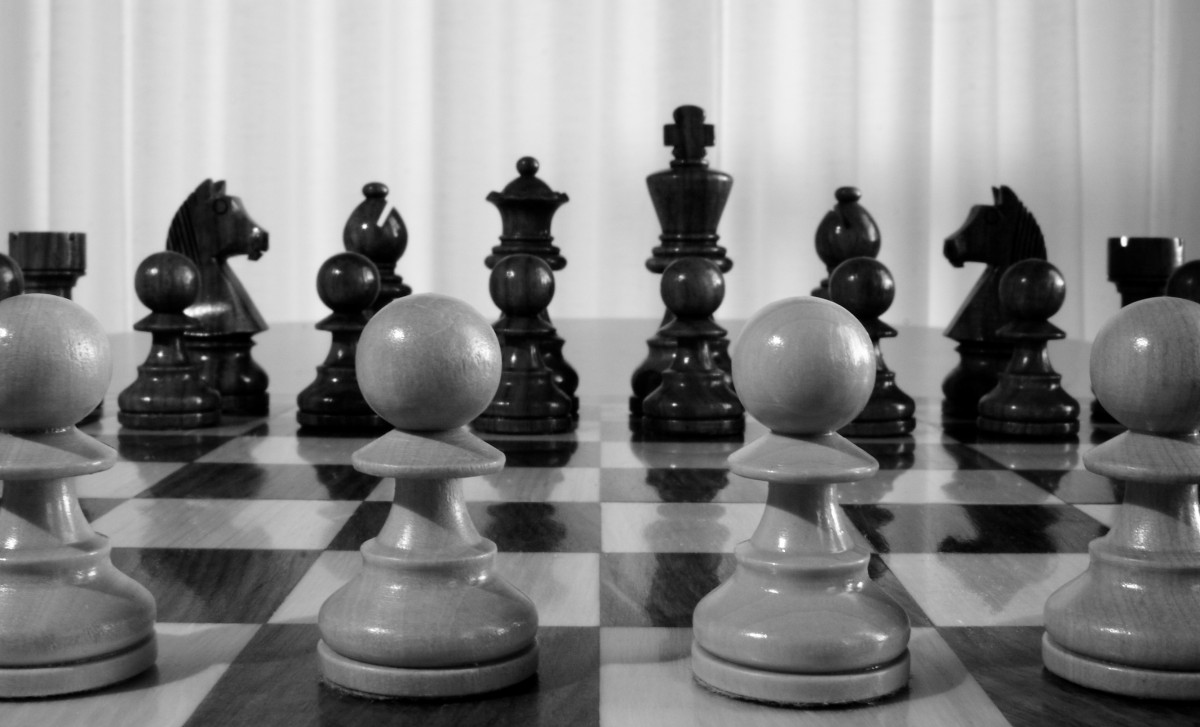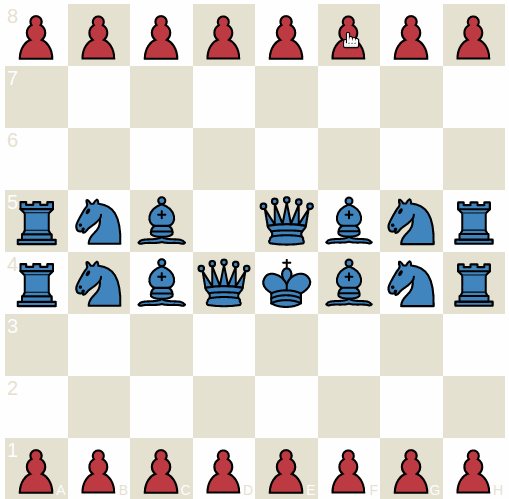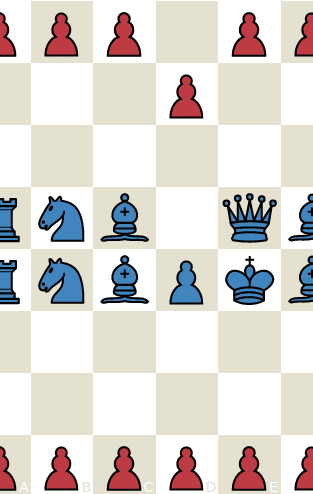What do you see when you look at a chessboard? Two rows of expendable pawns march into battle to protect the interests of the nobility, convinced to fight solely because they happen to be a different color. Sacrificing their lives to protect a bumbling and ineffectual king. The game itself is a blueprint for the kind of society the rulers wanted back when it was invented. All of us regular people convinced to fight each other for the comfort of a few.

And sadly, that’s more or less the way our world works to this day, except instead of fighting with swords, we sacrifice our time and our sanity to toil away for our masters.
Well not anymore. It’s about time for the pawns to unite and take on our real oppressors: the capitalist owners.
I wrote new rules for a chess game called Uprising Chess that pits the pawns against the noble pieces. And just like in life, in this game the nobles only maintain their special moves if they can keep the pawns in their place. You can play the game with a friend online at uprisingchess.web.app or join our discord to find other comrades to play with. Read on to learn more about the rules and philosophy behind the game.
The Rules of the Game
The rules of Uprising Chess are derived from standard chess, with some notable exceptions. The pieces move in largely the same way, but now the pawns are all one team and nobility pieces (rook, knight, bishop, queen, and king) are all the other.
Initial Setup
The game is played on a standard chess board except the pieces are rearranged, with a row of Worker pieces (pawns) along each outside edge (rows 1 and 8) and the Capitalist pieces (non-pawns) in two rows down the center (rows 4 and 5). When set up there will be 4 of each rook, knight and bishop, 2 queens, and a single king1.

Objective
The main objective for the Worker is to take the Capitalist king (AKA ending capitalism itself). The objective for the Capitalist team is to force the worker team to a forfeit (AKA “get back to work”).
But really, the meta-objective of this game is to get the word out about taking back some control of working people’s lives by a real-life general uprising.
Moves
For the most part the pieces move the same as in regular chess, but there are important differences that make this game very different.
-
Capitalist pieces (non-pawns), move like they do in regular chess, and Worker pieces (pawns) move like regular pawns. At first glance it would seem like the Capitalist pieces have a huge advantage, but there is a catch! In each column, if the outside two squares aren’t both filled, then any capitalist piece in that column converts to moving just like a pawn. We call the outside two squares of each column the “factories.” So if a single pawn has moved out of its factory then the capitalist pieces in that column move like pawns. One important thing to note is that the factory squares don’t have to be occupied by a worker piece for them to be “running.” Even a Capitalist piece could move into the factory squares and cause the other Capitalist pieces in that column to operate normally again.

-
Worker pieces (red pawns) mostly move like regular pawns (move 1 space, attack on the diagonal) from the outside inward. However, once a pawn reaches the middle two rows (rows 4 and 5) they switch from moving like pawns to moving like a king (move or attack in any direction). If the pawn in the center rows then moves back out to either of the outside 3 rows (1-3 or 6-8), it goes back to acting like a pawn on that side again. (Note that when a Capitalist piece is converted to a pawn it doesn’t move like a king in the center rows.)

-
Importantly, when Capitalist pieces “take” Worker pawns, the pawns aren’t necessarily removed from the board. If the pawn is taken in a column with an unoccupied factory, then the pawn is immediately returned to that factory (if both factories are unoccupied it is returned to row 1 by default). However, if the pawn is taken in a column where the factories are already both occupied, then the pawn IS removed from the game. When Worker pieces take Capitalist pieces, the Capitalist piece is removed from the game.

-
Finally, the king is not affected by the factories, and always continues to move as a standard king. However, the king is not allowed to move outside of the middle two rows of the gameboard (rows 4 and 5).
Scoring
As the game is played, a score is tallied by counting how many factories are running at the end of each turn. For each column with both factories occupied the Capitalists get 1 point, and for each with at least 1 unoccupied, the Workers get a point. Often 2 games will be played, exchanging who is Capitalist and who is Worker. If the Workers defeat Capitalism both times, then the player with the higher score as Capitalist is the overall winner.
Example Games
Those are all the basic rules of gameplay. Here’s an example game:
If you’re ready to play, you can go to uprisingchess.web.app and start a game, either against the AI or with a friend. Read on to learn more about the meaning behind the game.
The Philosophy of Uprising Chess
This game illustrates two important lessons about how the economy and political power is so messed up in the United States and how workers can do something to stop it.
The first lesson is that the special abilities that we seem to ascribe to our rulers are only possible because of the work that the rest of us do for them. Successful business persons, entertainers, politicians, and even scientists are often only successful because they have a team of people who are having their efforts extracted from them for less than they are worth. That’s why in the game, the moment the worker walks away from their “factory square,” the owners’ special power disintegrates and they become just another regular pawn. In that sense, the major challenge of this game and of our collective struggle is to coordinate our resistance to overcome the owners’ systems of oppression. In the strategy of this game, it’s the workers across factories stepping up and protecting each other.
The second lesson that I wanted to show was the focus on artificial political ties. In regular chess, pawns fight for the king of the same color, which is the same way our real-life social and political tribalism works. These distinctions mask the great similarity between working people around the world. A working class person in the US is way more similar to a working class person in China than either are to the people who rule over them, but political divisions are drawn so that we don’t see our universal humanity. Similarly the divisions between working class Republicans and Democrats also mask our shared struggle to overcome our exploitation.
Onward Comrades!
Although the game is new2 and we don’t fully understand all its nuances, we hope to start to build more strategy around it. If you really love the game and want to help support its development, feel free to check out our OpenCollective page for this project.
I also really hope that this game can help inspire more people to get involved with organizing to rise up and start to fight back against the pressures that the ruling class put on our lives. Capitalism is a tired old system, and it’s time for all people to work together to self-govern our economy.
So enjoy the game and lets do this!
-
Fun Names for Pieces: Because it can get confusing to explain, I described the game using the standard chess piece names. But really it’s much more fun to rename the nobility pieces. The names I came up with are: the rook = the landlord, the knight = the cop, the bishop = the influencer, the queens = CEOs, and the king = the owner. Hopefully that makes the game as fun for you as it does for me. ↩
-
Uprising Chess is an update of a previous version I had online called General Strike Chess. You can check out the old rules here. ↩
 will stedden
will stedden